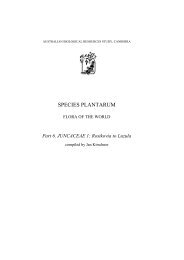Introduction - Species Plantarum Programme
Introduction - Species Plantarum Programme
Introduction - Species Plantarum Programme
Create successful ePaper yourself
Turn your PDF publications into a flip-book with our unique Google optimized e-Paper software.
12<br />
SPECIES PLANTARUM — FLORA OF THE WORLD (1999)<br />
Each principal organ (e.g. leaves, stamens) begins a new sentence and its attributes are<br />
separated by commas. Secondary organs (e.g. lamina, anthers) are preceded by a semi-colon<br />
and the attributes again are separated by commas. For example in the description of the leaf<br />
in Thymelaeaceae: attributes of the whole leaf are given first, separated by commas and<br />
ending with a semi-colon; a part of the leaf, the stipule, is then described in a new phrase.<br />
For each organ the noun is given first in the phrase, followed by the qualifying or descriptive<br />
adjectives. Thus, 'Petals 5, linear...' rather than 'Five petals, linear...'. It is most important that<br />
ambiguity be avoided. Make sure that the adjectives refer to the correct noun. See also the<br />
description of the ovary in Thymelaeaceae.<br />
Seedlings are not described unless they show important diagnostic features, but characters of<br />
the seed, such as endosperm, are often included.<br />
Reference to particular genera may be made in the family description (an example would be<br />
an atypical genus only tentatively placed in the family), but usually there is not space for<br />
this.<br />
Terminology<br />
Bearing in mind the readership of the Flora, the use of technical terms should be kept to a<br />
minimum. If a term must be used which is not in the Glossary it should be defined in a<br />
supplementary glossary in the relevant volume. Consider whether the term will be used often<br />
enough to justify its inclusion in a glossary. If needed for only one or two taxa it may be<br />
preferable to explain it in the description.<br />
Additional information<br />
Following the description there is a paragraph of general information on the family. It should<br />
include the number of genera and species and distribution worldwide. If the family contains<br />
plants of major economic importance they may be mentioned here.<br />
It may be necessary to discuss the concept of the family as treated by Brummitt and therefore<br />
as used in the Flora, and this should be done if the concept differs from other widely-used<br />
concepts. Alternative family names or spellings may be mentioned here.<br />
A pantropical family of about 20 genera and 450 species. Opinions vary as to the included<br />
genera and suprageneric classification. Lecythidaceae s. str. is confined to tropical America.<br />
Australian material has usually been placed in the family Barringtoniaceae, characterised as<br />
follows: stipules absent; flowers mostly in racemes, axillary or terminal; stamens incurved or<br />
inflexed in bud, sometimes without anthers; filaments shortly united at base or sometimes<br />
free.<br />
Amended from Fl. Australia 8: 1 (1982)<br />
If considered necessary there may be a further paragraph in which aspects such as<br />
morphology, evolution and other information of general interest to flora-users are discussed.<br />
Those seeking more detailed information will usually go to specialised references. Thus<br />
information presented here should be concise, review-type discussion, with references to<br />
more detailed or source material.<br />
The last item under the family treatment is a bibliography of selected important works on the<br />
family. It may also include non-taxonomic works: for example, in the Solanaceae, Fl.<br />
Australia 29: 2 (1982) those by Everist (1974) and Peterson (1979) on poisonous plants and<br />
Aboriginal use of the family, respectively. The references are arranged in chronological<br />
order. Authors' names are not abbreviated in this bibliography; titles of articles are included.












